The Reggia di Quisisana is a former royal residence located in the frazione of Quisisana, outside of Castellammare di Stabia, in the Metropolitan City of Naples, region of Campania, Italy.

The Reggia di Quisisana is a former royal residence located in the frazione of Quisisana, outside of Castellammare di Stabia, in the Metropolitan City of Naples, region of Campania, Italy.

A structure at the site is documented prior to 1200, but buildings have been modified over the centuries. Over the past century, it moved from royal summer residence to becoming a school, then a hotel, and finally falling into near ruin in the 21st century.
The term Quisisana is attributed to the term Domus de loco sano, or place of healing. The Villa is mentioned in 1280 relation to Charles I d'Anjou and mentioned in the Decameron. It was at the time part of a fortified town. In following centuries int became property of the Farnese family. But the villa was refurbished under the House of Bourbon including in 1758 Ferdinand IV of Naples, and later, Ferdinand II of Naples. In 1878, the House of Savoy ceded the property to the commune, and it became the elegant Hotel Margherita and later in 1923, Royal Hotel Quisisana until the 1960s. The layout is a jumble of wings. The surroundings are Italian Gardens. In 2016, the property is still under restoration. [1]

The Teatro Reale di San Carlo, as originally named by the Bourbon monarchy but today known simply as the Teatro di San Carlo, is an opera house in Naples, Italy, connected to the Royal Palace and adjacent to the Piazza del Plebiscito. It is the oldest continuously active venue for opera in the world, having opened in 1737, decades before either Milan's La Scala or Venice's La Fenice.

Castellammare di Stabia is a comune in the Metropolitan City of Naples, Campania region, in southern Italy. It is situated on the Bay of Naples about 30 kilometres southeast of Naples, on the route to Sorrento.

Museo di Capodimonte is an art museum located in the Palace of Capodimonte, a grand Bourbon palazzo in Naples, Italy. The museum is the prime repository of Neapolitan painting and decorative art, with several important works from other Italian schools of painting, and some important ancient Roman sculptures. It is one of the largest museums in Italy.
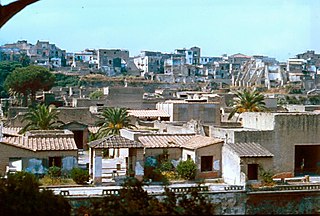
Ercolano is a town and comune in the Metropolitan City of Naples, Campania of Southern Italy. It lies at the western foot of Mount Vesuvius, on the Bay of Naples, just southeast of the city of Naples. The medieval town of Resina was built on the volcanic material left by the eruption of Vesuvius that destroyed the ancient city of Herculaneum, from which the present name is derived. Ercolano is a resort and the starting point for excursions to the excavations of Herculaneum and for the ascent of Vesuvius by bus. The town also manufactures leather goods, buttons, glass, and the wine known as Lacryma Christi.

Posillipo is a residential quarter of Naples, southern Italy, located along the northern coast of the Gulf of Naples.
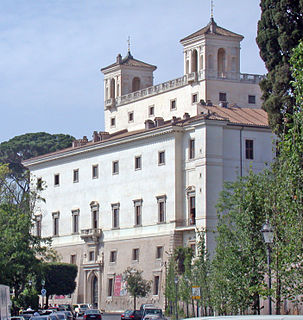
The Villa Medici is a Mannerist villa and an architectural complex with a garden contiguous with the larger Borghese gardens, on the Pincian Hill next to Trinità dei Monti in Rome, Italy. The Villa Medici, founded by Ferdinando I de' Medici, Grand Duke of Tuscany and now property of the French State, has housed the French Academy in Rome since 1803. A musical evocation of its garden fountains features in Ottorino Respighi's Fontane di Roma.

Vomero is a hilltop district of downtown Naples, Italy, with an area of approximately two square kilometers and a population of 48,000.

Castel Nuovo, often called Maschio Angioino, is a medieval castle located in front of Piazza Municipio and the city hall in central Naples, Campania, Italy. Its scenic location and imposing size makes the castle, first erected in 1279, one of the main architectural landmarks of the city. It was a royal seat for kings of Naples, Aragon and Spain until 1815.

The Villa Floridiana is a monumental house located amid a large park in the Vomero quarter in Naples, southern Italy. It overlooks the western Neapolitan suburbs of Chiaia and Mergellina.

The Villa Pignatelli is a museum in Naples in southern Italy. The villa is located along the Riviera di Chiaia, the road bounding the north side of the Villa Comunale on the sea front between Mergellina and Piazza Vittoria.
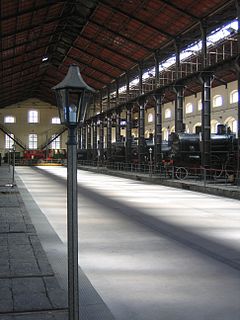
The National Railway Museum of Pietrarsa lies beside the Naples–Portici railway, between the city of Naples and the towns of Portici and San Giorgio a Cremano. Pietrarsa is an area among these villages in the past known as “Pietra Bianca” but it was renamed Pietrarsa after the eruption of the Vesuvius in 1631.

The Villa Rosebery is one of the three official residences of the President of the Italian Republic. The villa grounds cover 6.6 hectares.

Stabiae was an ancient city situated near the modern town of Castellammare di Stabia and approximately 4.5 km southwest of Pompeii. Like Pompeii, and being only 16 kilometres (9.9 mi) from Mount Vesuvius, this seaside resort was largely buried by tephra ash in 79 AD, in this case at a smaller depth of up to five metres.

The Royal Palace of Portici is a former royal palace in Portici, Southeast of Naples along the coast, in the region of Campania, Italy. Today it is the home of the Orto Botanico di Portici, a botanical garden operated by the University of Naples Federico II. These gardens were once part of the large royal estate that included an English garden, a zoo and formal parterres.
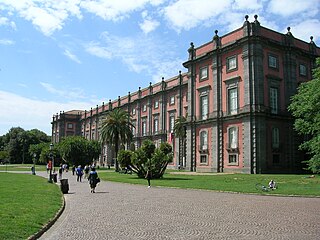
The Royal Palace of Capodimonte is a grand Bourbon palazzo in Naples, Italy, formerly the summer residence and hunting lodge of the kings of the Two Sicilies, and was one of the two Royal Palaces in Napoli. It today houses the National Museum of Capodimonte and art gallery of the city. "Capodimonte" means "top of the hill", and the palace was originally just outside the city, which has now expanded to surround it, and somewhat cooler than the city in summer.

The Regio Cantiere di Castellammare di Stabia was founded in 1783 by Sir John Acton, Prime Minister of Ferdinand IV of the Kingdom of Naples. Its first vessel, the Neapolitan ship of the line Partenope, was completed three years later. The shipyard was initially unable to build more than one ship of the line and a frigate simultaneously until it was enlarged by order of King Joachim Murat in 1808. It built its first steam-powered ship in the early 1840s.

The Poggio Reale villa or Villa Poggio Reale was an Italian Renaissance villa commissioned in 1487 by Alfonso II of Naples as a royal summer residence. The Italian phrase "poggio reale" translates to "royal hill" in English. The villa was designed and built by Giuliano da Maiano and located in the city of Naples, in the district now known as Poggioreale, between the present Via del Campo, Via Santa Maria del Pianto and the new and old Via Poggioreale. At the time it was built, a period when the capital city of the Kingdom of Naples was renowned for elegant homes with expansive vistas of the surrounding landscape and Mount Vesuvius, the villa was outside the city walls of Naples and was one of the most important architectural achievements of the Neapolitan Renaissance. Imitated, admired, robbed of its treasures by another king, left in ruins and partially destroyed, the summer palace of the King of Naples lives on in name as a style.
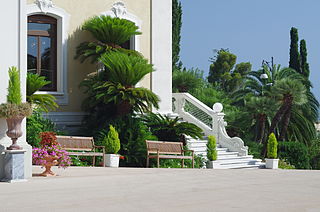
The Villa Regina Margherita di Savoia is a museum site on the via Romana of Bordighera in Riviera in province of Imperia.

The d'Afflitto family is an ancient princely family originally from Amalfi, documented since the IX century, and spread throughout southern Italy.